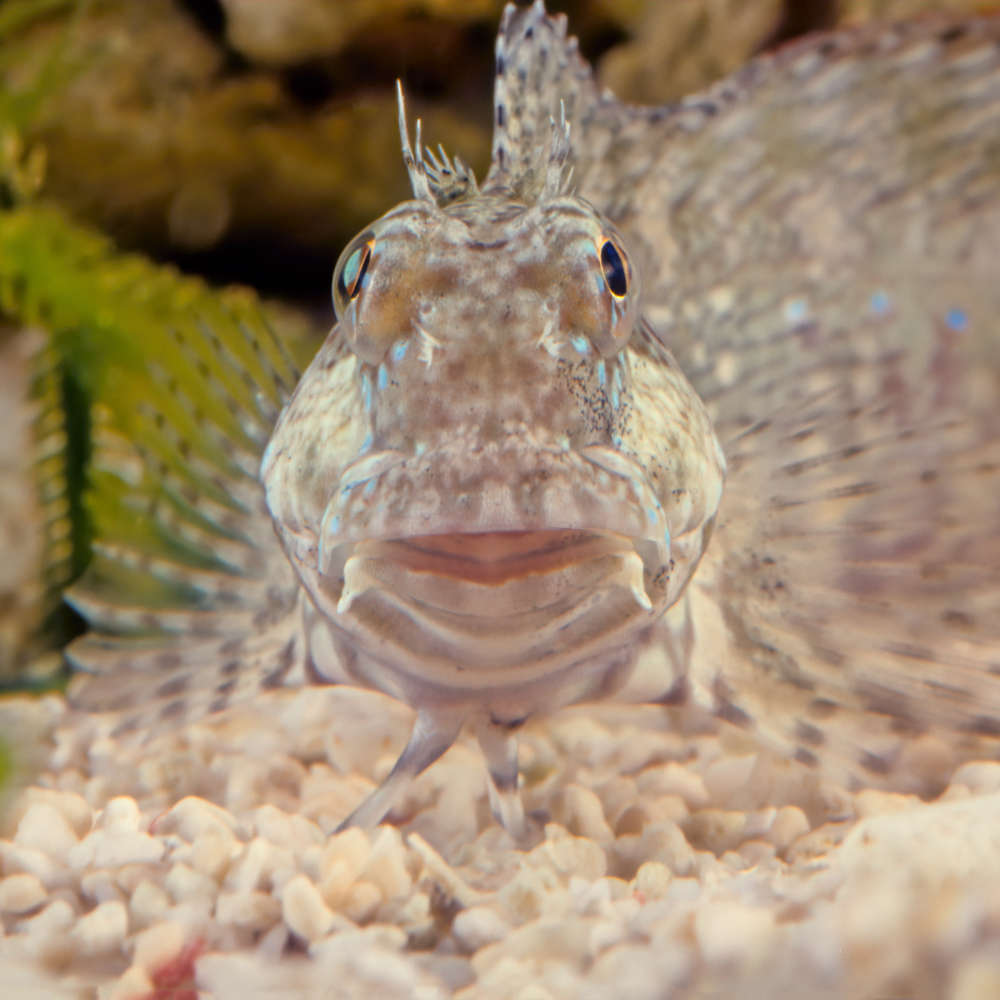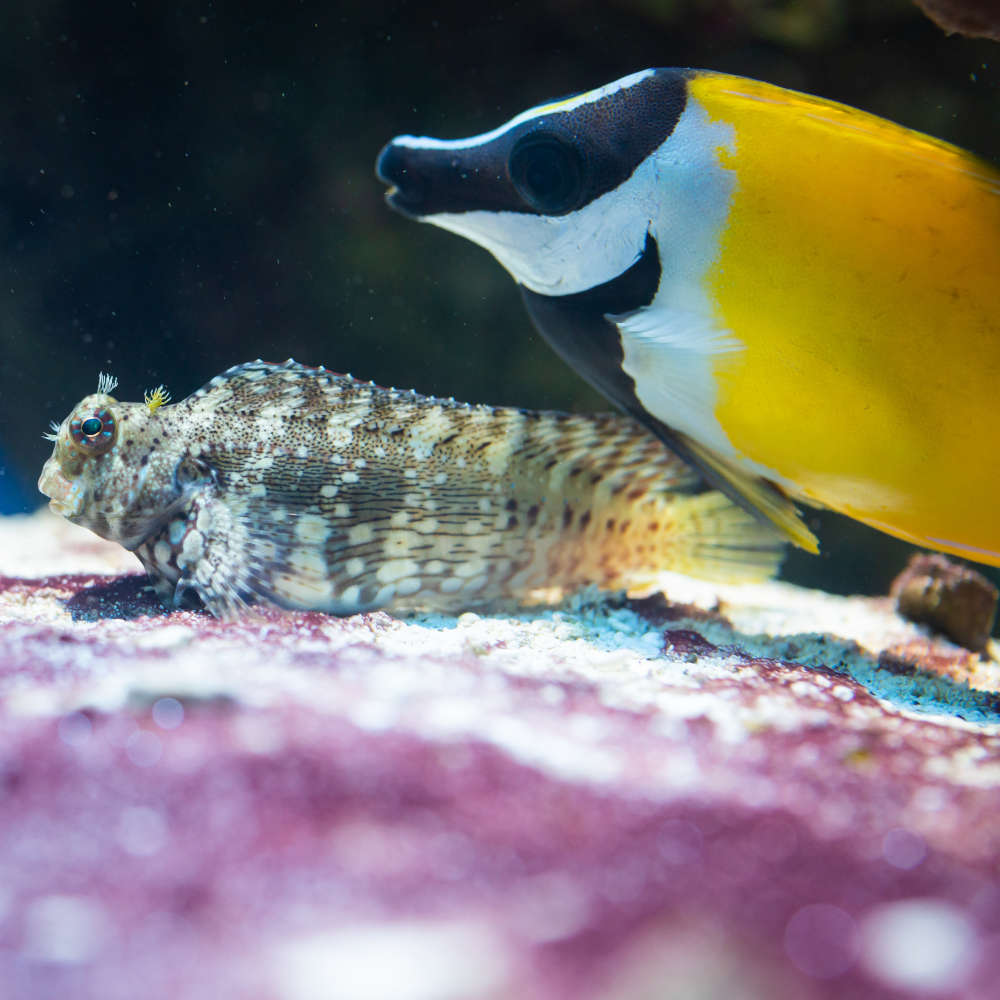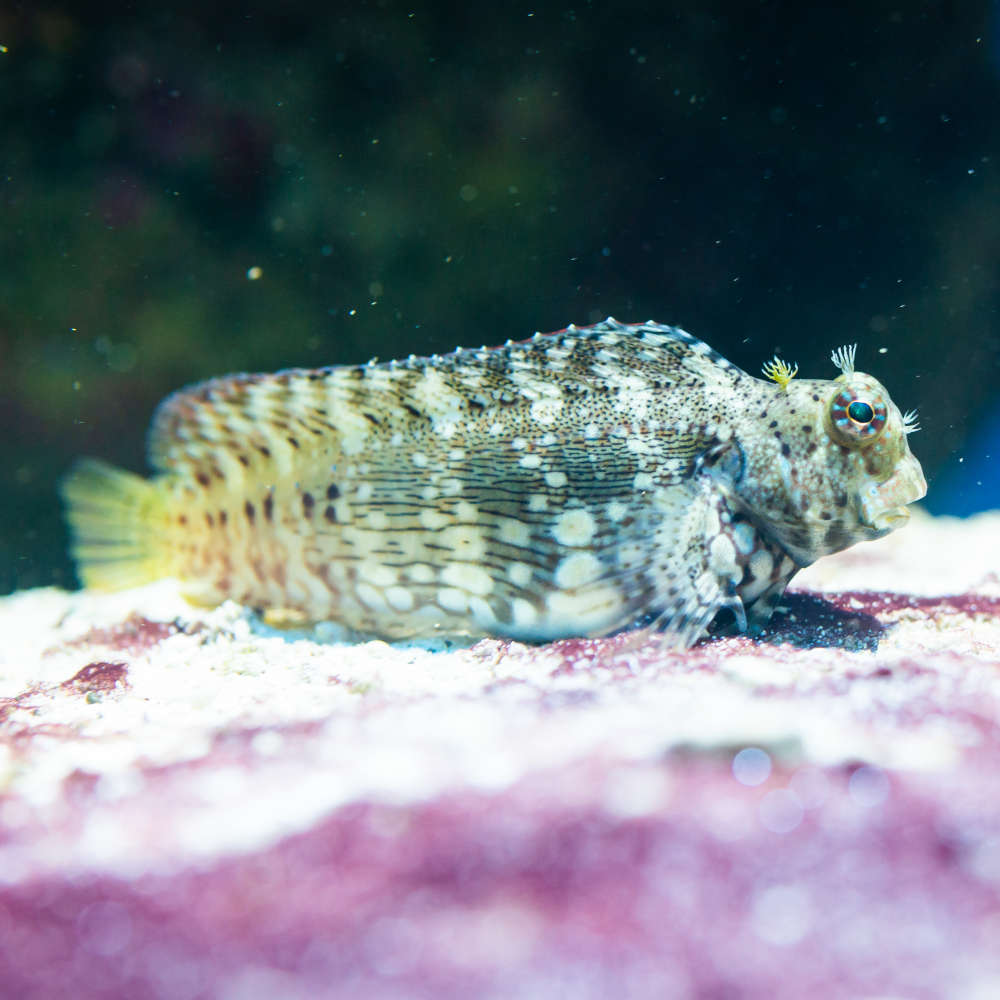If you want a distinct-looking fish for your marine aquarium, the lawnmower blenny is one to swoon over!
This fish is popular for beating stubborn algae. Its personality and antics are here to keep you entertained forever. With the proper diet and environment, this fish is totally low-maintenance.
So, if you’re interested in getting one, let’s learn to care for it the right way!
What is a Lawnmower Blenny Fish?
A lawnmower blenny is a saltwater fish which is popular for its unique looks and gets it name because it feeds on algae and reduces their strength in the aquarium.
| Origin | Widespread: Indo-Pacific Oceans, Red Sea, Ryukyu Islands, Great Barrier Reef |
| Order | Blenniiformes |
| Family | Blenniidae |
| Scientific Name | Salarias fasciatus |
| Common Names | Lawnmower blenny, Lined blenny, Jewelled blenny, Barred blenny, Banded jeweled blenny, Algae blenny, Sailfin blenny |
| IUCN Red List Status | Least Concern |
| Appearance | Elongated body with tan, green, and grey color and mottling, blunt head, round belly |
| Size | Around 14 cm (5.5 in) |
| Lifespan | Around 2-5 years |
| Temperament | Peaceful; Aggressive towards its own |
| Reef Safe | Yes, with caution |
| Tank Level | Bottom dwellers |
| Water Temperature | 72-78 °F (22-26 °C) |
| pH Level | 8.1-8.4 |
| Water Hardness | Up to 8-12 dGH |
| Care Level | Easy |
| Minimum Tank Size | 55 gallon |
| Tank Environment | Spacious, coral sand, low flow |
| Diet | Herbivorous |
| Tank Mates | Robust yet peaceful, non-algae-eating species that don’t intrude |
What is the Natural Habitat of Lawnmower Blenny Fish?
The lawnmower blenny is widespread all over the world. It’s most commonly spotted in the Indo-Pacific Oceans from East Africa and the Red Sea to Samoa, Micronesia Islands, and north to Ryukyu Islands to New Caledonia and the Great Barrier Reef.
In those areas, it spends most of its time in shallow lagoons, reef flats, algae-filled estuaries, and seaward reefs.
According to the 2009 assessment of The IUCN Red List of Threatened Species, the fish is assigned Least Concern status.
Which family does Lawnmower Blenny Fish belong?
The fish belongs to the Blenniidae family under the Blenniiformes order. This fish is scientifically known as Salarias fasciatus, but it’s globally known by various names:
- Lawnmower blenny
- Painted blenny
- Lined blenny
- Lineated blenny
- Jewelled blenny
- Barred blenny
- Banded blenny
- Banded jewelled blenny
- Jewelled rockskipper
- Algae blenny
- Sailfin blenny
- Rock blenny
- Horned blenny
Fun Fact: This fish can change its colors. It can make the front half of the body, along with the bars, pretty light or turn the rear half pale.
How does Lawnmower Blenny Fish look?

Now that you know about its origins, let’s get familiar with this unique-looking fish!
What is the Size of Lawnmower Blenny?
This fish generally grows up to 14 cm (5.5 in). However, depending on diet and genetics, different specimens can grow to 10-15 cm (4-6 in).
What is the Color of Lawnmower Blenny Fish?
The lawnmower blenny’s body is a mixture of tan, grey, and green, with seven thick grey-to-brown stripes that have lighter mottling.
There are little blue or black spots on its head, a reddish orange-tipped dorsal fin, and eyes ringed with small tan or cream speckles. It has a clear to opaque tail, pectoral fins, and white pelvic fins.
What are the Features of Lawnmower Blenny Fish?
This species has an elongated body, full and rounded belly, blunt head, cirri on the head, perched eyes, and a continuous dorsal fin. The pelvic fins are used to balance it when the fish is resting.
What is the difference between a male and a female Lawnmower Blenny Fish?
Compared to the female lawnmower, the male fish has a more stocky body, a large head, and several growths around the anal fin.
The female has one short and one long spine on its anal fins, while the male has two equal-length spines covered in fleshy tissue.
The male is also more dominant and territorial than the female.
What is the Behavior & Temperament of Lawnmower Blenny Fish?
The lawnmower blenny is a generally peaceful fish that’s territorial around other blennies or other similar-looking species.
When scared and at night, it stays hidden in holes of rockwork. Once it bonds with other species and its owner, it’s quite social. But around new fish or unfamiliar people, it hides. When afraid, it also turns darker to blend in with shadows.
It’s observant and curious. Most of the time, the fish swims from rock to rock, foraging for food.
It grazes on algae with its comblike teeth – you can see teeth or “kiss” marks on the tank if there’s noticeable algae formation. But don’t worry, it won’t scratch the glass. The jaw has a hard chopping-edge and is used as a defensive weapon.
What is the Lifespan of Lawnmower Blenny Fish?
On average, this species lives around 2-5 years. However, in my opinion, excellent care can help extend the lifespan to 6 years.
Author’s Note: The lawnmower blenny is reef-safe. But if it’s stressed or starved, it may bite coral polyps like acropora and montipora. Its perching activity also disturbs corals.
How to take care of Lawnmower Blenny Fish?

If you’re interested in adopting this fish, you must first prepare the right home for it. So, let’s begin!
What is the Tank Size required for Lawnmower Blenny Fish?
A solo lawnmower blenny with no tank mates must be housed in a 55-gallon tank at least.
However, two males or females – when in a less-than-100-gallon tank – can’t stand each other. A male-female pair can be established in a tank of over 100 gallons.
If you want a community tank, go bigger.
What is the Water Chemistry required for Lawnmower Blenny Fish?
To help your lawnmower blenny live the best life possible, water quality is important. So, follow these parameters!
- pH Levels: 8.1-8.4
- Water Temperature: 72-78 °F (22-26 °C)
- Water Hardness: Up to 8-12 dGH
- Ammonia: 0 ppm
- Nitrite: 0 ppm
- Nitrate: Below 10 ppm
- Synthetic Salt Level: 35 PPT
- Specific Gravity: 1.023-1.025
What is the Tank Environment needed for Lawnmower Blenny Fish?
The lawnmower blenny will be even happier and feel at home if you mimic its wild habitat. So, follow these suggestions.
Does Lawnmower Blenny Fish need Substrate?
The bottom-dweller stays perched on the substrate and darts between rocks. So, use fine coral sand as substrate and add lots of live rock. The live rock provides a surface for algae growth – the fish’s favorite snack!
Which Plants do Lawnmower Blenny Fish need?
The fish feeds on aquatic plants in nature. So, don’t incorporate fancy marine plants in the aquarium.
Which Lighting do Lawnmower Blenny Fish need?
Use normal to moderate lighting to promote enough algae growth in the tank. Natural light also works if there isn’t lots of shade.
Which Décor is needed for Lawnmower Blenny Fish?
Create caves and crevices using rock and PVC pipes as the fish’s hiding spot.
What type of filtration system does Lawnmower Blenny Fish require?
An efficient and robust filtration system like a sump filter is necessary to keep the aquarium clean.
Perform regular water changes:
- In up to 90-gallon tank: 15% biweekly for reef tank; 20-30% monthly for fish-only tank.
- In 100+ gallon tank: 10% biweekly or 20% monthly for reef tank; 20-30% every 6 weeks for fish-only tank.
- In any size tank with this fish only, no other fish/coral: Up to 20% monthly.
What is the Water Flow Rate for Lawnmower Blenny Fish?
The bottom dweller doesn’t like powerful water movement. So, ensure slow to minimal flow at the bottom water column.
Care Tip: In the wild, the fish is found in estuaries. But don’t house it in brackish waters.
What type of food does Lawnmower Blenny Fish eat?
The lawnmower blenny is a picky algae-eating herbivore. In the wild, it lives on diatoms, green microalgae, filamentous blue-green microalgae, and debris.
It may nip on corals, sponges, invertebrates, and their eggs and even accept meaty food when starved. However, the fish is not omnivorous, and excess or regular meaty food drastically reduces its lifespan.
Some great food options are:
- Chopped seaweed sheet
- Spirulina
- Nutrition-rich vegetarian flake and pellet
- Algae wafer
- Homemade chopped vegetable mix – cucumber, zucchini, lettuce
- Microalgae-based food
Grow Caulerpa and Chaetomorpha plant species in another tank and supplement the fish with it. Provide it with several meals a day.
However, the fish may not initially accept them and only crave algae. It may also try to starve itself when it can’t find algae.
To check whether your pet fish is well-fed, notice if its abdomen is full and round. If it’s not, feed it more algae-based food until it gets used to other food options.
Simultaneously, provide it with a range of other foods and observe the one that it prefers, and then provide it with that more often.
Lastly, even if there’s thick algae growth in your tank, don’t let the fish survive on tank algae alone. Otherwise, it’ll get sick.
What are the Tank Mates for Lawnmower Blenny Fish?
The lawnmower blenny is good enough on its own. However, if you have a big tank and keep your pet well-fed at all times, it can coexist with other robust yet peaceful species that don’t consume algae or intrude on its territory.
- Dartfish
- Peaceful wrasse (fairy, yellow coris, Christmas, pink-streaked wrasse)
- Basslet (assessor, royal gramma basslet)
- Pink skunk anemonefish
- Blue-green chromis
- Yellow tang
- Shrimp
- Snail
- Clam
Which Tank Mates to Avoid for Lawnmower Blenny Fish?
Avoid the following kinds of species with a lawnmower blenny:
- Similar-looking fish: They’ll break out in territorial fights.
- Gentle lagoon species: The fish may harass them or try to eat algal films on their body.
- Other algae eaters: The fish will compete for algae with them and starve.
- Large aggressive/predatory species: They threaten the fish.
Namely, some species to avoid are:
- Dwarf and large angel
- Other blenny
- Aggressive tang
- Goby
- Large wrasse
- Blue-spotted puffer
- Tessalata eel
- Lionfish
- Triggerfish
- Grouper
- Soapfish
- Algae-eating damselfish
- Large dottyback
- Pipefish
- Seahorse
What are the Common Diseases for Lawnmower Blenny Fish?
The lawnmower blenny is hardy and disease-resistant. However, it’s vulnerable to some common marine fish diseases like the following:
| Disease Name | Causes | Symptoms | Treatment |
|---|---|---|---|
| Marine Ich | External Protozoan Parasite | White spotting, flashing, fatigue, bad appetite | Add ich medicines, raise aquarium temperature |
| Marine Velvet | Parasitic Infection | Heavy breathing, fin sticking to body, yellow film on body, color loss, flashing, skin peeling, fatigue, bad appetite | Raise water temperature, dim the lights, add velvet medicine |
| Fin Rot | Bacterial Infection | Fin fraying, disintegration, and discoloration, fatigue, bad appetite | Improve water chemistry, remove objects that may physically injure it, add antibiotic |
Quick Tip: Avoid medicines with copper and permanganate that are unsuitable for scaleless fish.
How to Breed Lawnmower Blenny Fish?
Breeding lawnmower blenny in captivity is tough because these fish are picky about mates. Some also have difficulty sexually differentiating the fish.
No instances of home aquaria breeding of this fish are known. However, in June 2023, the Biota Group successfully bred the fish in captivity.
While all the details about the process aren’t out yet, here are the basic steps to breed the fish at home:
What are the Tank Conditions & Breeding Induction for Lawnmower Blenny Fish?
You need a dedicated big tank – 125 gallons or even more – to house the male and female fish. Decorate it like the main tank.
In the wild, the fish spawn around April-June. To mimic that, maintain a water temperature of 78 °F (25.6°F). Maintain all other water conditions according to this care guide. Feed the fish well to induce spawning.
How does Lawnmower Blenny Fish Mate?
As mentioned, they are picky about mates. But if the pair works, the mating process happens as follows:
The female fish lays eggs on the substrate, live rocks, or the tank surface. The eggs stay stuck with a filamentous adhesive. The male then fertilizes and guards the eggs until they hatch. Parent fish don’t eat the eggs or fry.
Breeding Tip: It’s not guaranteed the fish will mate. So, think hard about investing in the entire arrangement – like getting two blennies and buying a big tank. Invest only if you’re sure you can deal with failed attempts.
How to Buy Lawnmower Blenny Fish?
Since lawnmower blenny breeding is not that widespread in stores yet, most stores sell wild-caught lawnmower blennies. So, to ensure your new pet gets acclimated ASAP, ask the seller about the wild water conditions and mimic the same in your tank.
Before making the transaction, ensure these signs:
- Intact fins
- Enthusiastic feeding behavior
- Rounded belly – indicating well-fed and healthy fish
A word from FishInAquarium
The cute lawnmower blenny is a great starter option for novice aquarists. It’s not only inexpensive and widely available but also mesmerizes you and other visitors with its camouflaging abilities.
So, if you found this article interesting, share it with other aquarists in your circle. If you face any trouble in raising this baby, drop us an email, and we’ll help you out!


